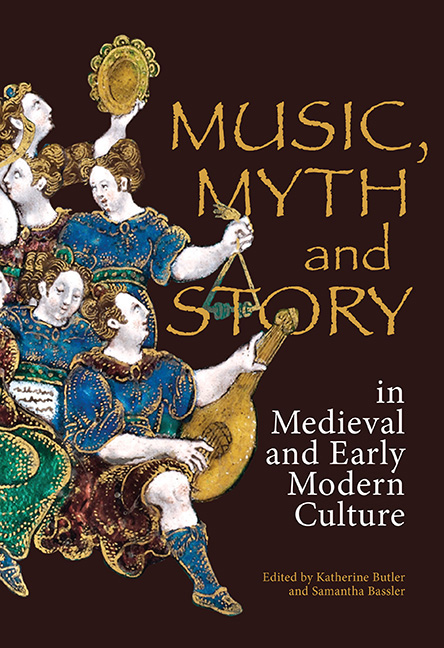Book contents
- Frontmatter
- Contents
- List of Illustrations
- List of Contributors
- Editors’ Note
- Introduction
- I MYTH IN MEDIEVAL MUSIC THEORY AND PHILOSOPHY
- II ICONOLOGIES OF MUSIC AND MYTH
- III MYTHS IN RENAISSANCE PHILOSOPHIES OF MUSIC
- IV MYTH AND MUSICAL PRACTICE
- 8 How to Sing like Angels: Isaiah, Ignatius of Antioch and Protestant Worship in England
- 9 In Pursuit of Echo: Sound, Space and the History of the Self
- V NARRATIVES OF PERFORMANCE
- VI MYTH AND MUSIC AS FORMS OF KNOWLEDGE
- VII RE-IMAGINING MYTHS AND STORIES FOR THE STAGE
- Bibliography
- Index
- Studies in Medieval and Renaissance Music
8 - How to Sing like Angels: Isaiah, Ignatius of Antioch and Protestant Worship in England
from IV - MYTH AND MUSICAL PRACTICE
Published online by Cambridge University Press: 24 October 2019
- Frontmatter
- Contents
- List of Illustrations
- List of Contributors
- Editors’ Note
- Introduction
- I MYTH IN MEDIEVAL MUSIC THEORY AND PHILOSOPHY
- II ICONOLOGIES OF MUSIC AND MYTH
- III MYTHS IN RENAISSANCE PHILOSOPHIES OF MUSIC
- IV MYTH AND MUSICAL PRACTICE
- 8 How to Sing like Angels: Isaiah, Ignatius of Antioch and Protestant Worship in England
- 9 In Pursuit of Echo: Sound, Space and the History of the Self
- V NARRATIVES OF PERFORMANCE
- VI MYTH AND MUSIC AS FORMS OF KNOWLEDGE
- VII RE-IMAGINING MYTHS AND STORIES FOR THE STAGE
- Bibliography
- Index
- Studies in Medieval and Renaissance Music
Summary
RELIGIONS are deeply invested in stories. An important reason for this is their capacity to make political and moral suggestions through allegory and metaphor, but stories also shape religious observance in literal ways. The Last Supper, recounted in the four gospels, is commemorated not simply in words, but by the act of breaking bread, a form of remembrance Luke's version of the story explicitly commands. Those accounts recall a doctrinally significant episode, but they also physically inform its ritualisation.
This chapter examines two stories with a similarly material relationship to liturgical tradition. These ancient tales of eminent figures who saw and heard angels praising God were used in the medieval and early modern periods to assert that alternating or responsive performance had heavenly roots. Changing ritual practices and contemporary religious politics fundamentally shaped the ways in which the stories were received. Yet a political narrative of the favour and disfavour they found offers only a partial picture of their role within contemporary religious cultures. After explaining their histories, I argue that they appealed to common beliefs about the spiritual function of music and the effects of collaborative worship, empowering their survival in the face of critique. I further suggest that this reflects the capacities of myth to instruct, inspire and explain, not in lieu of, but in fluid relation to, empirical, rational and critical inquiry.
Hearing Heaven
The first story is found in Isaiah 6:2–3. The prophet sees the Lord sitting on a throne attended by two angels called seraphim, who ‘cried one to another and said, “Holy, holy, holy the Lord, God of hosts; all the earth is full of his glory.” ‘
Interpretations of this familiar hymn have rested largely on the symbolism perceived in its words, not on its scriptural context. Yet scripture does remark on how the hymn is sung: the angels ‘cried one to another’. This point did not escape early Christian authors. Augustine likened the seraphim to the Old and New Testaments, which also seemed to speak reciprocally by presenting and fulfilling prophecy. Isidore of Seville added a component to the Augustinian comparison to illuminate an emerging liturgical practice. ‘Two choirs singing together alternatim’, he writes, is ‘like the two seraphim and the two testaments calling to one another’.
- Type
- Chapter
- Information
- Music, Myth and Story in Medieval and Early Modern Culture , pp. 141 - 155Publisher: Boydell & BrewerPrint publication year: 2019

